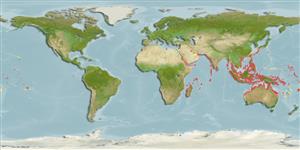Common names from other countries
Environment: milieu / climate zone / depth range / distribution range
Ökologie
seewasser riff-verbunden; tiefenbereich 3 - 20 m (Ref. 90102). Tropical; 36°N - 31°S, 30°E - 146°W
Indo-West Pacific: Red Sea and East Africa to New Caledonia and Vanuatu, north to southern Japan. Reported from Fiji and Tuvalu (Ref. 12596).The exact range is uncertain because of confusion of this species with Sphyraena jello and Sphyraena qenie (Ref. 9768).
Size / Gewicht / Alter
Maturity: Lm ? range ? - ? cm
Max length : 90.0 cm TL Männchen/unbestimmt; (Ref. 2334); common length : 60.0 cm TL Männchen/unbestimmt; (Ref. 9768)
Rückenflossenstacheln (insgesamt): 6; Rückenflossenweichstrahlen (insgesamt): 9; Afterflossenstacheln 2; Afterflossenweichstrahlen: 7 - 9. Many typical chevron dark markings crossing lateral line on body; caudal fin largely blackish. No gill rakers on first arch, upper and lower gill arch with rough platelets, each platelet not bearing distinct spine.
Found near prominent current-swept lagoons or seaward reefs (Ref. 9710). Also in bays and inner turbid lagoons (Ref. 9768). Nocturnally active, but occurring in relatively large schools during the day (Ref. 9768). Sold fresh or processed into fish cakes (Ref. 27550).
Life cycle and mating behavior
Geschlechtsreife | Fortpflanzung | Ablaichen | Eier | Fecundity | Larven
Randall, J.E., G.R. Allen and R.C. Steene, 1990. Fishes of the Great Barrier Reef and Coral Sea. University of Hawaii Press, Honolulu, Hawaii. 506 p. (Ref. 2334)
IUCN Rote Liste Status (Ref. 130435)
CITES (Ref. 128078)
Not Evaluated
Bedrohung für Menschen
Harmless
Nutzung durch Menschen
Fischereien: kommerziell; Sportfisch: ja
Mehr Information
NamenSynonymeMetabolismusRäuberÖkotoxikologieFortpflanzungGeschlechtsreifeAblaichenFecundityEierEientwicklung
ReferenzenAquakulturAquakultur ProfilZuchtlinienGenetikElectrophoresesVererbbarkeitKrankheitenVerarbeitungMass conversion
PartnerBilderStamps, Coins Misc.LauteCiguateraGeschwindigkeitSchwimmstilKiemenoberflächeOtolithsGehirngrößeSehfähigkeit
Tools
Zusatzinformationen
Download XML
Internet Quellen
Estimates based on models
Preferred temperature (Ref.
115969): 24.5 - 29.3, mean 28.4 (based on 3674 cells).
Phylogenetic diversity index (Ref.
82804): PD
50 = 0.5000 [Uniqueness, from 0.5 = low to 2.0 = high].
Bayesian length-weight: a=0.00759 (0.00466 - 0.01235), b=2.92 (2.78 - 3.06), in cm Total Length, based on LWR estimates for this species & Genus-body shape (Ref.
93245).
Trophic level (Ref.
69278): 4.5 ±0.0 se; based on diet studies.
Widerstandsfähigkeit (Ref.
120179): mittel, Verdopplung der Population dauert 1,4 - 4,4 Jahre. (K=0.3).
Fishing Vulnerability (Ref.
59153): Moderate vulnerability (36 of 100).
